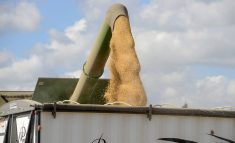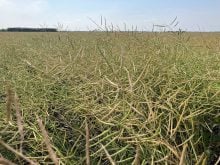The grain and oilseed markets saw choppy activity during the first week of the 2022-23 crop year, with canola down and up in reaction to several outside forces.
On the whole, canola prices ended back around where they closed the 2021-22 crop year, with attention back on weather conditions ahead of the harvest.
Ukrainian grain finally started moving through the Black Sea after months of uncertainty as an agreement brokered by the United Nations and Russia in Turkey allowed for safe passage out of the war-torn country. With more than 20 million tonnes of grain reportedly in export positions, it remains to be seen how much will move, but the signs of activity were enough to trigger some selling in the North American corn and wheat markets.
Read Also

Manitoba data in on Maizex canola hybrids
Maizex Seeds has two new canola hybrids for western Canadian farmers to plant for the 2026 crop. The latest Manitoba trial data is in on the new varieties.
The weakness in grains was also bearish for oilseeds, including canola, with tensions between the United States and China also weighing on prices. A visit by U.S. House of Representatives Speaker Nancy Pelosi to Taiwan raised concerns over possible retaliation from China, as the country disputes the sovereignty of the island territory. Pelosi came and went without incident, but China began conducting military exercises in the area in a show of strength after her departure.
Losses in crude oil and uncertainty over a looming global recession were also overhanging the agricultural markets. Canola found its footing and showed some stability as the week progressed.
The most active November contract appears to have found solid support around the $800 per tonne level, with recent moves toward that level uncovering solid demand. Old crop supplies remain tight, and there are enough concerns across the Prairies that even with a return to average yields, the supply/demand balance should remain tight.
The Canadian Grain Commission released its final weekly report for the 2021-22 crop year, showing total canola exports during the July to August timeframe of 5.1 million tonnes. That was roughly half of what moved the previous year as the 2021 drought cut into available supplies.
Total domestic use came in at 9.3 million tonnes, which was only down by 1.3 million from the previous year as the industry prioritized the domestic crush over export movement.
After last year’s drought, the current canola crop is looking to be in much better shape, which should allow for a return to more typical export movement. However, late seeding in many areas has development running behind normal, which could leave some fields susceptible to an early frost.
In the U.S., hot and dry midwestern weather forecasts were keeping the soybean and corn markets on edge, although sporadic rains were helping keep crop ratings looking reasonably good. The U.S. Department of Agriculture releases updated supply/demand estimates on Aug. 12, which could provide direction for grains and oilseeds. Weather in the later half of August is the primary driver.
















